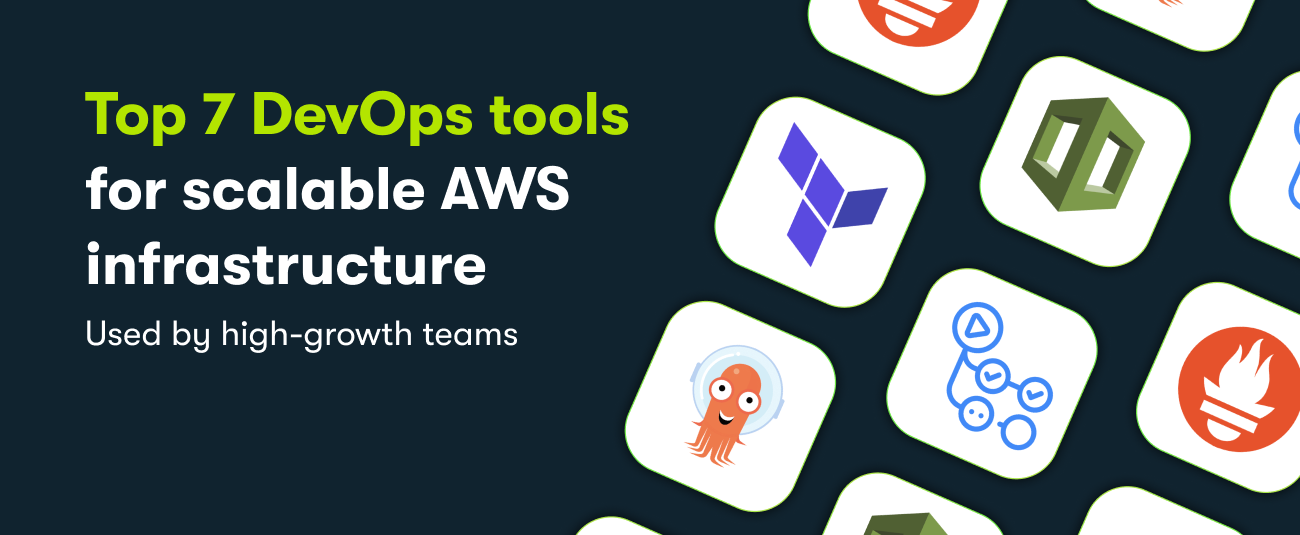Scaling on AWS isn’t just something big companies worry about anymore—it’s something every growing team has to get right.
- BrainScale Solutions – provides cloud IT services and DevOps outsourcing
- contact@brainscale.cloud
Armenak Armenakyan 9, Yerevan 0010, Armenia
Top 7 DevOps Tools for Scalable AWS Infrastructure (Used by High-Growth Teams)
- Home
- Top 7 DevOps Tools for Scalable AWS Infrastructure (Used by High-Growth Teams)

Top 7 DevOps Tools for Scalable AWS Infrastructure (Used by High-Growth Teams)
Scaling on AWS isn’t just something big companies worry about anymore—it’s something every growing team has to get right. Whether you’re a startup trying to move fast or an established team handling more users every day, how you manage your cloud setup matters. AWS gives you the base, but the tools you use on top of it are what really help you scale smoothly.
At BrainScale Solutions, we’ve helped teams at all stages build and manage their AWS infrastructure. And from what we’ve seen, the teams that grow the fastest are the ones who choose the right tools for the job.
Here are seven DevOps tools we see top teams using—and why they’re so effective.
1. Terraform: Infrastructure as Code That Grows With You
Terraform has become the go-to Infrastructure as Code (IaC) tool for a reason. It lets you define your entire AWS infrastructure using code, store that code in version control, and reuse it across environments. This not only reduces human error but ensures consistent, repeatable deployments.
As companies scale, managing environments manually becomes unsustainable. Terraform offers a clean, automated alternative—whether you’re provisioning a few EC2 instances or spinning up a multi-region, multi-account setup.
High-growth teams love Terraform for its ecosystem support, modular structure, and ability to manage complex infrastructure at scale.
2. AWS CloudFormation: Native Power With Full AWS Integration
For teams deeply embedded in the AWS ecosystem, CloudFormation provides native IaC capabilities without the need for third-party tooling. It’s particularly valuable when paired with services like StackSets or nested stacks, enabling consistent deployment across AWS accounts and regions.
While it may require more AWS-specific knowledge than Terraform, it’s incredibly powerful when used correctly and eliminates the need for external plugins or wrappers.
Many AWS-heavy teams choose CloudFormation for tighter integration and official support from AWS services.
3. ArgoCD: GitOps for Kubernetes, Made Easy
When deploying to EKS or other Kubernetes clusters on AWS, ArgoCD is quickly becoming a DevOps favorite. It follows the GitOps model, where Git is the single source of truth. Once set up, ArgoCD automatically syncs your cluster to match your Git repo—ensuring everything is always up-to-date.
This approach not only enhances security and transparency, but also simplifies rollback, auditability, and team collaboration.
For cloud-native teams managing containers, ArgoCD bridges the gap between developers and operations sufficiently.
4. Prometheus + Grafana: Observability That Scales With You
No DevOps stack is complete without observability. Prometheus and Grafana provide real-time monitoring and alerting capabilities across your infrastructure. Prometheus collects and stores metrics, while Grafana turns them into insightful dashboards.
As your system grows more complex, having the right monitoring in place is non-negotiable. These tools help identify performance issues, monitor resource utilization, and ensure uptime.
Teams trust Prometheus and Grafana to stay ahead of issues before customers notice.
5. GitHub Actions (or GitLab CI/CD): CI/CD Where Your Code Lives
Modern development teams want CI/CD pipelines that integrate directly into their version control workflows. GitHub Actions and GitLab CI/CD offer just that—seamless automation for building, testing, and deploying applications.
With native AWS integrations (like deploying to Lambda, ECS, or S3), these tools remove friction and accelerate release cycles. Plus, they scale beautifully with team size and project complexity.
For fast-moving teams, integrating automation directly into the codebase leads to faster feedback and fewer bottlenecks.
6. AWS CodePipeline + CodeBuild: A Fully Managed CI/CD Option
For teams looking to stay AWS-native and avoid managing external CI/CD tools, AWS CodePipeline and CodeBuild offer a managed solution for continuous integration and deployment. They’re simple to set up and integrate well with other AWS services.
While not as flexible as third-party options, they’re great for smaller teams or projects that need to go live quickly without worrying about infrastructure management.
When time-to-market is critical, managed services like CodePipeline can accelerate launches.
Final Thoughts
Building scalable infrastructure on AWS takes more than just good intentions. It requires the right tools. These DevOps tools are used not because they’re trendy, but because they solve real problems for real teams moving fast.
Whether you’re optimizing your CI/CD pipelines, improving visibility, or hardening your security posture, the right DevOps stack enables you to scale without chaos.
Need help implementing or optimizing your DevOps strategy?
At BrainScale Solutions, we specialize in helping fast-growing teams architect and automate infrastructure on AWS. Let’s build something that scales with confidence.
3 Comments
Comments are closed.
Interactively formulate client-focused communities through functional portals. Dynamically supply backward-compatible potentialities
Quickly recaptiualize technically sound value and error-free communities. Proactively transition 2.0 catalysts for change and pandemic leadership skills.
Thanks a lot for your informative comments.